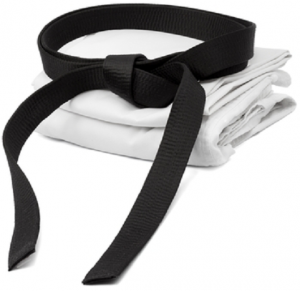This page provides details on proper Karate ranks & titles. It will help you to address Karate instructors and students by their correct Karate rank or title. These Karate ranks & titles are used by most Karate styles including Shotokan, Goju-Ryu, Wado-Ryu, Shito-Ryu and Kyokushin. For additional Japanese terminology, please visit Black Belt Wiki’s main Karate Terminology section.
Meaning of Karate Ranks & Titles
Most Karate styles use a 10 kyu and 10 dan system borrowed from Judo. This system is also used by other Japanese martial arts. The “Black Belt” was designed as a way to show competence in the art, not mastery of it. Achieving 1st dan is the beginning of the journey, hence why kyus count down and then dans count up.
Karate Ranking System
- No grade: white belt, though some schools use white as 10th kyu
- 10th kyu: usually yellow belt
- 9th kyu: usually orange belt
- 8th – 4th kyu: some order of blue, green, purple and sometimes red, and sometimes with two kyu’s per color
- 3rd kyu: brown belt
- 2nd kyu: brown belt
- 1st kyu: brown belt
- Provisional Black Belt: (shodan-ho) “old school” trial black belt, basically meaning that you get your black belt but have to show over time that you have truly earned it. Not often used in modern school.
- Junior Black Belt: similar to provisional black belt but for teen students who have the knowledge of a 1st dan but not the life experience, and physical capabilities of an adult. (this is sometimes a blackbelt with no dan stripe or a bicolor black/white belt)
- 1st – 5th dan: Black Belt (shodan, nidan, sandan, yodan, godan)
- 6th – 10th dan: “Black Belt” that is sometimes bicolored or with additional stripes often red, white, or gold. These dans are almost exclusively given not for learning new katas and moves but fine tuning the art within yourself, helping others though the art, and overall dedication.
Related Pages – Shotokan Belt Levels
Karate Titles
- Dai-Sempai: dai meaning “big” or great” and often used in the context “big brother of the class” (usually given to a 1st kyu brown belt and junior black belt)
- Senpai/Sempai: means “mentor” or “senior” often used to indicate an assistant instructor (usually 1st and 2nd dan)
- Sensei: means “one who came before” or has walked the path before and often used to indicate a fully capable teacher (usually given at 2nd or 3rd dan but can be given later)
- Shihan: is a master title for a senior instructor (earlies given at 4th dan) and equivalent to a doctorate degree
- Renshi: is a master title meaning “polished expert” (usually given at 6th dan)
- Kyoshi: is a master title meaning “teacher of teachers” (usually given at 7th dan)
- Hanshi: is a master title for the head master of a style
- Soke: is the absolute head of a style
- Shodai-Soke: is the founder of a style
What is the highest level of Karate?
The answer is that it depends on the Karate style and organization. However, in many Karate organizations, 10th dan tends to be the highest level. This rank is usually reserved for the founder or leader of a Karate style.
Karate Belt Levels
This video explores belt levels in different Karate styles such as Shotokan and Shito-Ryu
How to Earn a Black Belt in Karate
Black Belt

Image owned by Black Belt Wiki & may not be copied.